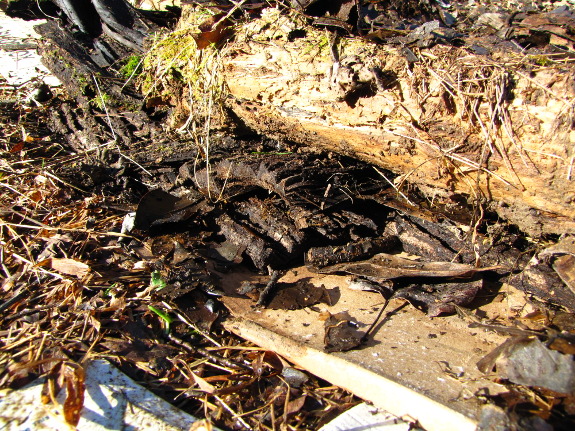
Bark kill mulch

I saw Mark peeling the
bark off the walnut logs we were stacking into the
woodshed and realized that he was right --- barkless logs will probably
dry faster. Even dry bark doesn't make good firewood, so I
decided to snag the biomass for my garden.
My first impulse is to
see how the bark fares as the kill layer of a kill
mulch. I never
have enough corrugated cardboard to go around --- maybe a couple of
thicknesses of bark will do just as well?
Want more in-depth information? Browse through our books.
Or explore more posts by date or by subject.
About us: Anna Hess and Mark Hamilton spent over a decade living self-sufficiently in the mountains of Virginia before moving north to start over from scratch in the foothills of Ohio. They've experimented with permaculture, no-till gardening, trailersteading, home-based microbusinesses and much more, writing about their adventures in both blogs and books.
Want to be notified when new comments are posted on this page? Click on the RSS button after you add a comment to subscribe to the comment feed, or simply check the box beside "email replies to me" while writing your comment.

I've recently learned that most bark, regardless of species, is a pest ambivalator for lack of a better term. Ok, it's not a real word . . . yet. What I mean by this is that wood-eating insects do not actually eat bark but are completely ambivalent to its presence. They may bore through it to get to the yummy wood, but if they can find an easier access they will leave the bark alone. Commercially available bark veneer siding is guaranteed for 70 years untreated and unpainted!
Most barks are not all-round insect deterrents though a few are, like Black Walnut, Cedar varieties and quite a few exotics. You can use Black Walnut trimmings or crushed hulls as a powerful insecticide. How this could effect your mulching is a question way out of my league but I might worry that juglone will also kill off / drive off earthworms and healthy microorganisms.
Shannon --- "Juglone exerts its effect by inhibiting certain enzymes needed for metabolic function" just means that juglone keeps plants from doing something. Whether that something is related to germination or regular growth is what I'm most interested in.
Jeremiah --- Fascinating information! I had no idea that people made siding (or anything else) out of bark.
I can see why insects would leave bark alone --- I don't think it's got much nutrition to it. I've found that the bark doesn't really produce much heat when burning firewood, so I often slide it off before using the wood. While that sounds irrelevant, I've been noticing that the way wood works in the stove relates to how fungi and animals make use of it.
Ah, here we go --- http://www.wvu.edu/~agexten/hortcult/fruits/blkwalnt.htm says "Juglone has experimentally been shown to be a respiration inhibitor which deprives sensitive plants of needed energy for metabolic activity." (Which just goes to show, you can't believe everything you hear at parties. That's where I picked up the germination tidbit.)
Other useful tidbits from the internet include:
*The most dangerous parts of the tree are the buds, nut hulls, and roots. But leaves and stems do have some juglone.
*Composting leaves can break down the juglone in two to four weeks. In the soil, it might take two months. Not sure how long it would take to break down juglone in the bark.
*Quality soil mitigates ill effects. Good soil drainage makes walnut trees less likely to impact nearby plants, and adding organic matter to the soil can help.